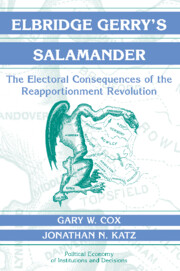Book contents
- Frontmatter
- Contents
- List of Tables and Figures
- Preface
- Part I Introduction
- Part II Democrats and Republicans
- 3 A Model of Congressional Redistricting in the United States
- 4 The Case of the Disappearing Bias
- 5 The Role of the Courts in the 1960s Redistricting Process
- 6 Bias, Responsiveness, and the Courts
- 7 Redistricting's Differing Impact on Democratic and Republican Incumbents
- Part III Incumbents and Challengers
- Part IV Conclusion
- References
- Author Index
- Subject Index
- Titles in the series
5 - The Role of the Courts in the 1960s Redistricting Process
Published online by Cambridge University Press: 10 November 2009
- Frontmatter
- Contents
- List of Tables and Figures
- Preface
- Part I Introduction
- Part II Democrats and Republicans
- 3 A Model of Congressional Redistricting in the United States
- 4 The Case of the Disappearing Bias
- 5 The Role of the Courts in the 1960s Redistricting Process
- 6 Bias, Responsiveness, and the Courts
- 7 Redistricting's Differing Impact on Democratic and Republican Incumbents
- Part III Incumbents and Challengers
- Part IV Conclusion
- References
- Author Index
- Subject Index
- Titles in the series
Summary
In the previous chapter, we focused on redistricting plans drawn prior to the courts' entry into the redistricting process. During this precourt period, reversionary plans – that is, the plans that would stand in force should the state legislature and governor be unable to agree on a new plan – were automatic. Both their content and the conditions under which they would come into force were prespecified and did not depend on the decisions of any strategic actor. In contrast, after the Supreme Court's reapportionment decisions, individual courts decided both the content of the reversionary plan and, to some degree, the conditions under which it would be invoked. In this chapter, we begin to consider the political consequences of this change from automatic to discretionary reversions.
The first two sections consider how the partisan complexion of the courts supervising (or potentially supervising) redistricting actions in the 1960s might in theory have affected the plans ultimately used. Based on an extension of the model developed in the previous chapter, we argue that one should expect court partisanship to affect the partisan bias and responsiveness embodied in the implemented plan, even if the court did not impose a plan and even though bias and responsiveness were not justiciable.
The third section provides qualitative evidence that each court's partisan complexion did affect its decisions. The fourth section provides quantitative evidence that each court's partisan complexion, relative to that of the plan it was judging, affected the level of malapportionment it was prepared to tolerate. The final section concludes.
- Type
- Chapter
- Information
- Elbridge Gerry's SalamanderThe Electoral Consequences of the Reapportionment Revolution, pp. 66 - 86Publisher: Cambridge University PressPrint publication year: 2002



